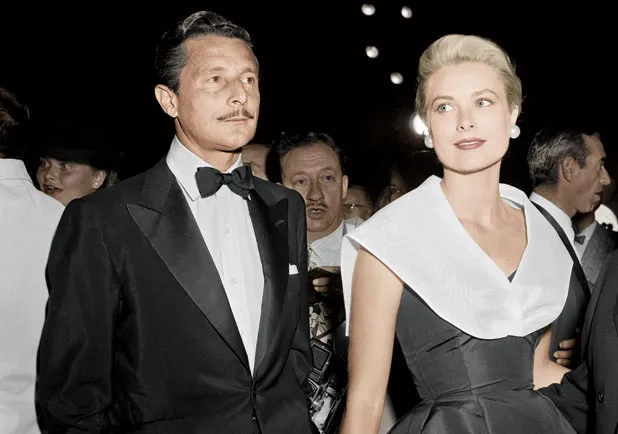Oleg Cassini wasn’t just a designer—he was a brand, a myth, a social whirlwind wrapped in cashmere and controversy. His life, stitched together from aristocratic roots, Hollywood love affairs, and a legendary partnership with Jacqueline Kennedy, had all the flair of a costume drama. But after his death in 2006, a far messier, real-life drama unfolded—one involving secret marriages, bitter heirs, disputed fortunes, and a woman who may have quietly held his legacy in her hands for decades.
This is the story of the original Cassini Royale: part fashion empire, part family feud, and part societal spectacle.
A Final Bow in White Fur
Six weeks before his death, Oleg Cassini made his final public appearance at a design-awards show at New York’s Whitney Museum. At age 92, his vitality had waned, but his flair for theatrics remained undimmed. On his arm was Carol Alt, a statuesque former supermodel 46 years his junior, dressed to stun in white fur. He played his role to perfection—still the elegant playboy, the debonair couturier, the continental Casanova.
Even as his health failed, Cassini curated his image like a master stylist. Behind that image, however, lay decades of tangled love affairs, family estrangements, and a legacy he couldn’t quite control.
Born Into Old World Glamour
Cassini came from a world that no longer exists. The son of a Russian-Italian aristocrat who once served as the czar’s ambassador to the U.S., and a beautiful but penniless countess, Cassini arrived in America already half-legend. Alongside his younger brother Igor—known to the world as gossip columnist Cholly Knickerbocker—he belonged to the jet set before that term even existed.
Their lives were glamorous and explosive. Igor coined the term “jet set” and married five times; he once earned himself a tarring and feathering in retaliation for an unflattering article. Liz Smith, who worked under him, later described the brothers as “pirates with a gloss of education and culture.”
Hollywood, Tierney, and a Tragic Romance
In 1940, Cassini moved to Hollywood, where he took a job designing costumes. Within a year, he met and married Gene Tierney, the ethereal beauty who quickly rose to stardom. Their relationship was passionate and turbulent. He designed many of her most iconic screen looks, but their private life was haunted by tragedy.
In 1943, their daughter Daria was born severely disabled—a result of Tierney contracting German measles during pregnancy. The actress fell into recurring bouts of depression, and their marriage slowly unraveled. Though they briefly reunited, the final divorce came in 1953.
Their second daughter, Christina (known as Tina), was born in 1948 and would later play a central role in the Cassini estate saga.
A Designer to Camelot
Cassini’s most enduring professional triumph came in the 1960s, when he became First Lady Jacqueline Kennedy’s exclusive designer. Her pillbox hats, sleek suits, and understated glamour carried his signature style—and her influence catapulted him from respected designer to global icon.
He made the most of Camelot. He licensed his name aggressively, attaching it to perfumes, sunglasses, luggage, even Chrysler car interiors. Long before celebrity branding became standard practice, Cassini understood the value of his name.
“He was more a pioneer in creating a brand,” said licensing mogul Frank Mori. “Jackie Kennedy made him a star.”
A Man Obsessed With Image
Oleg Cassini knew that being seen with beautiful women was good for business. His relationships, whether real or rumored, included Anita Ekberg, Marilyn Monroe, and Grace Kelly. Of Kelly, he said she was the ultimate “top top girl.” Monroe, on the other hand? He cruelly referred to her as “a little polo pony.”
He made few apologies. “In his maturity,” reported the Boston Globe in 1990, “Cassini is brutally honest about living up to his womanizing image because it was good for business.”
But behind the charm and swagger, he was meticulously guarded. Especially about one secret: a marriage no one knew about.
The Secret Wife
After Cassini’s death in March 2006, his daughter Tina received a call in Kenya: her father had suffered a stroke. She rushed to New York, only to discover—after two days of frantic searching—that he had already died. A doctor at the hospital informed her that his “wife” had been contacted.
Wife?
The name Marianne Nestor emerged. According to the doctor, Nestor had produced a marriage certificate dated 1971, issued in London. Tina was stunned. She had never heard her father acknowledge a marriage to this woman, who was just a few years older than her.
Their secret union had lasted 34 years—at least on paper.
The Woman Behind the Curtain
Who was Marianne Nestor? To the outside world, she was part of “the office”—a presence at Cassini’s side but never confirmed as anything more. Richard Turley of Avenue magazine once recalled being introduced to “Peggy and Marianne, from my office” at Cassini’s home. Nothing more.
But Nestor had deep roots in the Cassini enterprise. She helped run the design and licensing business. She had intimate knowledge of the archives, the letters, the royalty agreements.
After Cassini’s death, Nestor took control—over the estate, the funeral, and Cassini’s narrative. She reportedly did not want a public service, but Tina insisted, arranging a Russian Orthodox funeral in the church where Cassini’s parents and brother were buried.
And yet, Tina and her children were treated as afterthoughts. At the post-funeral lunch, they weren’t seated at the main table. “My mother was treated like a ghost,” said her son Alexandre.
The Cassini Estate: A Battle of Blood and Paperwork
Four years after Cassini’s death, his estate remained unsettled. The centerpiece of the dispute was the Oleg Cassini brand: the licensing empire, the perfume and bridal lines, his extensive archives—including letters from Jacqueline Kennedy and Grace Kelly—and his personal collections of toy soldiers and Native American artifacts.
Tina had no knowledge of what was in the will. When she finally saw it, a fierce legal battle ensued.
At the heart of the fight was a question of authenticity and power: Was Marianne truly his wife? Did she have the right to dictate his legacy?
The Nestor Sisters: Society’s Quiet Hurricanes
Marianne wasn’t the only Nestor with connections to powerful men. Her sisters Brenda and Peggy had also danced through the fringes of high society. All three had at some point pursued modeling or acting.
In the 1970s, Peggy Nestor had a child with Bernie Cornfeld, a flamboyant financier who eventually landed in jail. Cornfeld was so close to Cassini that he once bought 25% of Cassini’s company. Their connection was personal and financial.
Marianne and Oleg’s wedding certificate, in fact, listed their London address as Cornfeld’s town house.
The Licensing Legacy: A Brand Before Its Time
While Oleg Cassini may not have ranked among the world’s most innovative designers, he was one of the first to understand fashion as business. He built a licensing empire that became the blueprint for modern designers.
“He rented his name,” said Frank Mori, comparing Cassini to Michael Jordan. “He was not the most highly respected designer, but he latched onto Camelot.”
He also understood visual branding: military jackets for women, Nehru collars for men, bold colors, and ethnic prints. It wasn’t just about taste—it was about being seen.
The Daughter Left in the Shadows
Christina Cassini—Tina—had always wanted a closer relationship with her father. Despite receiving financial support, she lived modestly in Paris as a divorced mother of four. In 2009, she battled ovarian cancer and nearly died.
She claims she was blocked at every turn by Marianne Nestor, whom she saw as manipulative and exclusionary.
“I was like Cinderella,” Tina once said.
Her son Alexandre described the years after Cassini’s death as a nightmare of exclusion and disrespect.
The Designer, the Legend, the Man
Oleg Cassini was a contradiction: a true aristocrat who lived like a Hollywood rogue; a fashion mogul who was never fully accepted by the couture elite; a man who publicized everything—except the one relationship that defined his final decades.
He reveled in playing the part of the gentleman rogue. But in the end, that carefully tailored mask left a legacy of confusion, resentment, and court battles.
A Legacy Still in Limbo
More than a decade after his death, the name Oleg Cassini still evokes glamour. His influence lives on in bridal gowns, red carpets, and Camelot nostalgia. But the full story of his estate, his secret marriage, and his fractured family remains unresolved.
It’s a tale worthy of a fashion dynasty—a story where love and ambition, secrecy and style, collided in high society’s final golden age.






